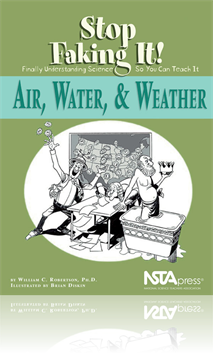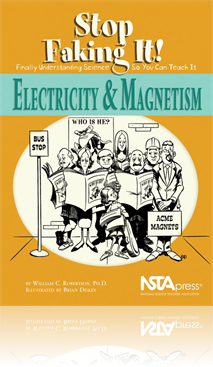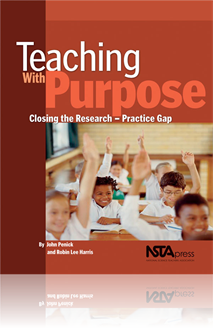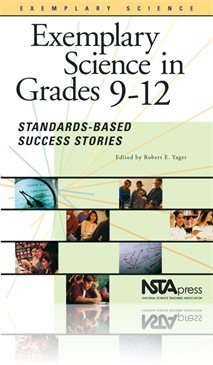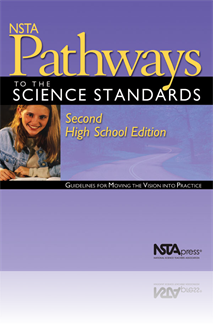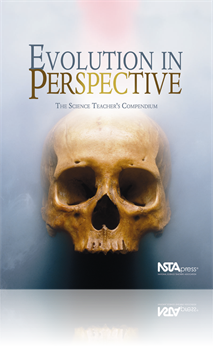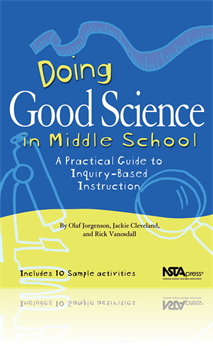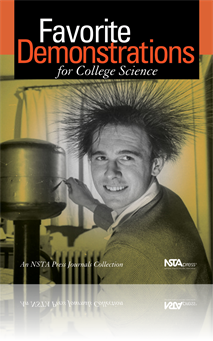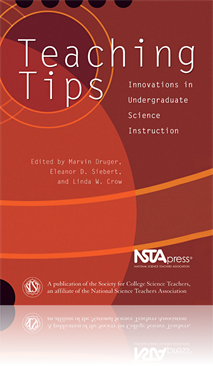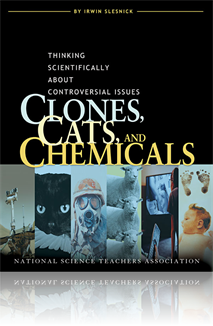All Book Chapters
Book Chapter
In the previous chapter, we dealt with how the properties of air and water affected small-scale weather such as the formation of clouds, the formation of fog, and how comfortable you feel at different times of the year. In this chapter, we're going t...
Book Chapter
So far, small-scale and large-scale weather patterns have been dealt with. What seems to interest people most, though, are the "special" events related to weather. Those special events include thunderstorms, tornadoes, hurricanes, floods, and drought...
Book Chapter
Connecting Electricity and Magnetism
As discussed at the beginning of the book, there is an intimate connection between electricity and magnetism, which will be further addressed in this chapter as well. We'll end up with a scientific model for what magnetism is, what makes something a ...
Book Chapter
Making a Case for a Research-Based Teaching Rationale
This chapter demonstrates the importance of developing a detailed plan or rationale for teaching science that will help you achieve improved results in the classroom. Although every teacher's plan or rationale will be different in some ways, it has ...
Book Chapter
Elements of a Research–Based Rationale
In Chapter 1, the 10 key aspects that most plans embrace were mentioned. This chapter looks more closely at how to address these 10 key aspects. This includes setting goals for students and defining the roles of students and teachers in the classro...
Book Chapter
Developing a Research–Based Rationale
Developing a research-based rationale requires formulating a way of thinking about teaching. Rather than a casual, weekend effort, the creation of a complete rationale is a long-term enterprise that may last for years and may never be finished (and p...
Book Chapter
Implementing Your Rationale and Becoming a Mentor
In this chapter, the authors discuss how you can implement your rationale in the classroom and use it to become a mentor to others. As you develop and implement research-based rationale for teaching, you will find yourself changing—teaching and com...
Book Chapter
It's the "Little Things" That Can Change the Way You Teach
The "Little Things" project is a unique curriculum on the soil ecology of microbes that offers students an opportunity to engage in real science research, develop an understanding of the biochemistry of soil microbes and to cultivate in students, an ...
Book Chapter
Sing and Dance Your Way to Science Success
The research in this chapter was conducted at Independence High School in Charlotte, North Carolina to determine whether creating a different kind of classroom learning environment could help at-risk students achieve success in biology. The research ...
Book Chapter
Student Inquiry at the Illinois Mathematics and Science Academy
This chapter features the Student Inquiry Program at the Illinois Mathematics and Science Academy (IMSA)—an internationally recognized, pioneering educational institution created by the State to develop talent and stimulate excellence in teaching a...
Book Chapter
Teacher Action Research on Interactive Lectures: Engaging All Students in Verbal Give-and-Take
Amherst Regional High School is a public school located within a five-college community in western Massachusetts. Most of the work outlined in this chapter springs from a course on Collaborative action research (Car). Conducting action research allow...
Book Chapter
Stop Talking, Start Listening: Turning Didactic Science Teaching on Its Head
In this chapter, the authors hope to illustrate science instruction that focuses on real-world problems and features the science teacher performing a variety of research-based strategies during any given teaching segment. It is a major goal also of t...
Book Chapter
The Sky's the Limit: A More Emphasis Approach to the Study of Meteorology
This chapter features curriculum for the senior Meteorology elective at the Marymount School of New York—an all-female, independent school in New York City. The curriculum is aligned with the National Science Education Standards (NSES) More Emphasi...
Book Chapter
The author—a teacher at Rockwall High School in Texas—covers specific standards in this chapter which includes selecting and adapting curriculum, as well as guiding students in active and extended scientific inquiry. The course is intended to mak...
Book Chapter
Successes and Continuing Challenges: Meeting the NSES Visions for Improving Science in High Schools
The 15 programs described in this book illustrate where we are with respect to realizing the vision of the 1996 National Science Education Standards (NSES)—eight years after their publication and acceptance as needed new directions. The hope and ex...
Book Chapter
Technology and Cooperative Learning: The IIT Model for Teaching Authentic Chemistry Curriculum
Computer technology emerged as a viable tool for classroom instruction. This chapter reflects upon a case study of a high school chemistry classroom where the computer was used in a unique way to deliver and direct curriculum on acids and bases. The...
Book Chapter
Inquiring Minds Want to Know All About Detergent Enzymes
This enzyme unit demonstrates how students can learn using inquiry and questioning techniques. By providing students the opportunity to share ideas, evaluate problem statements, develop hypotheses, design experiments, and make conclusions, they acqui...
Book Chapter
Teaching Ecology by Evolving and Revolving
This chapter features an ecology course started by Harry Hitchcock at Clinton High School (CHS) in Clinton, Tennessee, in response to a need for more elective courses in science. This ecology class is a hands-on course that engages students in person...
Book Chapter
The program highlighted in this chapter—the Biomedical Engineering Challenge-Based Curriculum—features science curricula that meet numerous More Emphasis standards through the use of challenged-based “Legacy Cycle” materials. Challenges are b...
Book Chapter
RIP-ing Away Barriers to Science Education: Inquiry Through the Research Investigation Process
This chapter presents the Research Investigation Process (RIP), an "inquiry" and "critical thinking" model of science education at two high schools—the Academy for the Advancement of Science and Technology (AAST) and Halau Lokahi Public Charter Sch...
Book Chapter
Modeling: Changes in Traditional Physics Instruction
This chapter highlights the modeling approach to high school physics instruction—a curriculum design that engages students in constructing a few basic models of physics. Model development begins with students working in cooperative groups, designin...
Book Chapter
Guided by the Standards: Inquiry and Assessment in Two Rural and Urban Schools
This chapter features the environment in which the authors—Teresa and Steve—work. Both are at schools near the border of Mexico, and while both have a student body of predominantly Hispanic, one is a rural school and one is an urban school. The N...
Book Chapter
The author stumbled across the Physics, Physiology, & Technology (PP&T) program while attending a Modeling Instruction meeting. Modeling Instruction is a national science program that has been tried and proven. In this chapter, the author describes b...
Book Chapter
Aristotle took the ideas of those who had come before him and melded them into a grand theory that attempted to explain and classify everything know. It was an enormous accomplishment, and it set a base for science that is still with us today. ...
Book Chapter
For decades, many of the nation’s life science classrooms have been anything but lively. Biology has been criticized for being content heavy, overloaded with vocabulary, and tested by rote. Six to seven hundred pages of text, presented to teenagers...
Book Chapter
Introduction to Watershed Dynamics
The title of this book, Watershed Dynamics, refers to the idea that streams, rivers, lakes, and other water bodies are dynamic systems, continuously changing in many ways—physically, chemically, and biologically. Have you ever wondered why some st...
Book Chapter
Opponents to teaching the theory of evolution declare that it is only a theory and not a fact; and that science relies on observation, replication, and experimentation, but nobody has seen the origin of the universe or the evolution of species, nor h...
Book Chapter
Classroom Management and Safety
Welcome to the challenge of making good science come to life in your classroom. In this chapter, we look at how to get the science classroom ready for inquiry-based lessons and how to prepare students for engaging, productive, and safe activities. In...
Book Chapter
A Bright Idea: Reinforcing Logico-Deductive Reasoning
Many students in freshman- and sophomore-level science courses have little experience formulating testable hypotheses. However, an accurate comprehension of the scientific method is critical for understanding experimental design and for the success ...
Book Chapter
Successful learning is more apt to occur when students are engaged in discovering and building their own frameworks of knowledge. To meet this standard, teachers must design work that actively involves students in asking questions and finding answers...
Book Chapter
This book is a compilation of brief descriptions of innovative and effective ideas, tips, and approaches in undergraduate science teaching. Assessment must be aligned with learning goals and successful learning is promoted by frequent assessment, whi...
Book Chapter
Every course covers some concepts that will present challenges to many students. Once those challenges have been identified how do you present them for successful learning? This part contains multiple articles with descriptions of effective ways that...
Book Chapter
It's only human nature to ask, "If sea anemones can clone themselves without trying, and the natural cloning powers of plants are so easily exploited, why can't we begin learning how to clone ourselves?" This chapter presents an overview of the natur...
Book Chapter
The only form of gambling under the control of the state and to which the profits accrue directly for the state, is the lotteries. In this chapter, we'll compare its profits with private gambling enterprises, and search for the true worth of this mec...
Book Chapter
Cats and Their Impact on Wildlife Populations
Could you be harboring a killer in your home? Is it possible that the cute little cat snoozing so angelically on the sofa is one of the major predators of wildlife in the United States? With a U.S. population of 60 million cats, researchers estimate ...
Book Chapter
Transplanting embryonic stem cells from embryo into adult as a means of rejuvenating diseased cells, tissues, and organs poses ethical and moral challenges. In recent years, stem cell-derived nerve and glandular tissue has been transplanted into the ...
Book Chapter
Chemical and Biological Weapons of Mass Destruction
Chemical warfare began in prehistoric times with the use of such weapons as poisoned arrows. However, World War I was the beginning of modern-day chemical warfare. The birth of biological warfare evolved during World War II. As a result, mankind has ...
Book Chapter
Robotic Versus Manned Space Travel
Manned space flights are supported by the notion that humans have an innate need to explore the universe—in specially protected spacecrafts—but at great risk to life. Congress wants manned space travel to support an industry that builds the costl...
Book Chapter
Many genetic disorders can be detected with tests of blood and chromosomes. Genetic screening is the large-scale use of these tests as part of the public health program. Different members of society, worldwide, have advocated genetic screening to ach...
Book Chapter
Many think that television and other media are primarily responsible for the aggressiveness of American youth and the youth of Western nations. Several experimental and longitudinal studies have provided considerable support to this claim. However, t...



